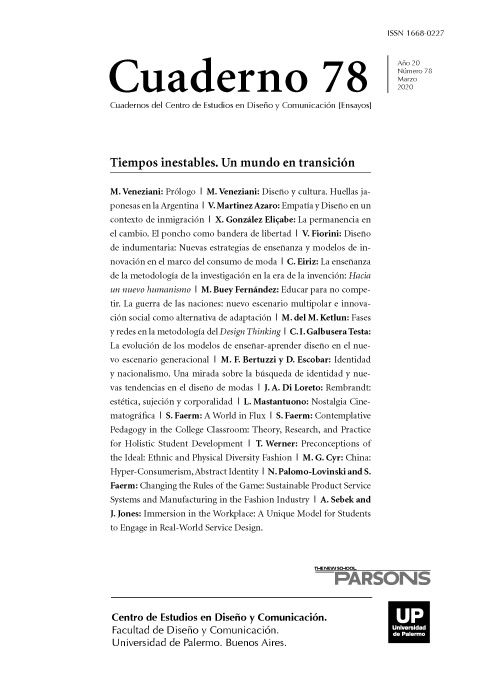China: Hyper-Consumerism, Abstract Identity
Abstract
Is the 21st century the Chinese century? Westernization has changed nearly all facets of life in China, except for politics (Wu, 2009). This has created mass-confusion, enthusiasm, rebellion, romanticism, and idealism. The 1990s manufacturing industries continued to dominate the acceleration of consumerism in the 21st century and created, more than ever, a bizarrely giant, abstract world of identity that is self-created and sustained. This paper examines the politics of abstract desire, hyper-consumerism, and the notion of fantasy in the Chinese fashion industry. Today, hundreds of giant “hyper-malls” found all over China are connected to the distribution of fake “stuff.” These commercial emblems have become an integral part of China’s visual and social landscape. The marketplace of fake goods using Western brand images (e.g. logos) has grown for centuries to become an abstract superstructure of falsely branded lifestyles and design integrity. The global rise of hyper-consumerism gave China the ultimate opportunity to create a new identity for itself while importing the dream of luxury: The Buying Power. This paper focuses on abstracting the notion of hyper-consumerism and interrogating the relationship between visual advertisement, its materiality, and its representation in the global marketplace. How does advertising contribute to the production of consumer goods? Can we create a cyclical vision for new materials? How is the value of luxury created, displaced, transformed, and consumed through space and time?
References
AFP. (2016, May 6). Gucci apologises over Hong Kong funeral fakes row. Hong Kong Free Press. Retrieved from https://www.hongkongfp.com/2016/05/06/gucci-apologises-hongkong-funeral-fakes-row/
Amed, I. (2014, May 5). Building Vogue China. The Business of Fashion. Retrieved from https://www.businessoffashion.com/articles/global-currents/building-vogue-china
Assandri, F. (2015). Supermarket of the dead: Burnt offerings in China & the cult of globalized consumption. W. Scheppe (Ed.). Cologne: Walther König.
Bain, M. (2017, June 4). The meteoric rise of Chinese consumerism will reshape the world, and maybe even destroy it. QUARTZ. Retrieved from https://qz.com/994345/the-meteoric-rise-of-chinese-consumerism-will-reshape-the-world-and-maybe-even-destroy-it/
Banta, A. (2017, November 10). Why Chinese consumers opt for luxury goods over travel experiences. Luxury Society. Retrieved from https://www.luxurysociety.com/en/articles/2017/11/do-consumers-prefer-luxury-goods-or-travel-experiences/
Baudrillard, J. (1968). The system of objects. Paris, France: Editions Gallimard.
Beam, C. (November 6). One man, 1.7 million square meters. New Republic. Retrieved from https://newrepublic.com/article/115463/worlds-largest-building-area-chinas-newcentury-global-center
Craciun, M. (2013). Material culture and authenticity: Fake branded fashion in Europe. London, UK: Bloomsbury Academic.
Crewe, L. (2017). The geographies of fashion: Consumption, space, and value. London, UK: Bloomsbury Press.
Cheung, A. (2017, February 12). How to reach the elusive Chinese millennial? [interview with Amed, I.] The Business of Fashion. Retrieved from https://www.youtube.com/watch?v=lOuRlamvjpo and https://www.businessoffashion.com/articles/voices-video/angelica-cheung-how-to-reach-the-elusive-chinese-millennial-consumer
Debord, G. (1967/1994). Society of the spectacle. (D. Nocholson-Smith, Trans.). London: Zone Books.
Douglas, M. & Isherwood, B. (1979). The world of goods: Towards an anthropology of consumption. London: Allen Lane.
Foucault, M. (1988). Technologies of the self: A seminar with Michel Foucault (1st ed.). L. H. Martin & H. Gutman (Eds.). Boston, MA: University of Massachusetts Press.
Fernandes, C. (2014, December 7). The history of knockoffs in China. Conquer China. Retrieved from http://www.conquer-china.com/land-knockoffs-can-china-innovate/
Gruendl, H. & EOOS. (2007). The death of fashion: The passage rite of fashion in the show window. New York, NY: Springer Vienna Architecture.
Jolas, M. (1958/1994). The poetics of space: The classic look at how we experience intimate places. (G. Bachelard, Trans.). Boston, MA: Beacon Press.
Julier, G. (2017). Economies of design. London, UK: Sage.
Koolhass R. & Hoster, H. (2013). Junkspace with running room. London, UK: Notting Hill Editions.
Larousse. (2018). Paris, France: Larousse Incorporated. Retrieved from www.larousse.fr
Lin, G. (2016, April 28). Dead serious: Gucci warns afterlife paper offering shops over copyright. Hong Kong Free Press. Retrieved from https://www.hongkongfp.com/2016/04/28/dead-serious-gucci-warns-afterlife-offering-shops-over-copyright/
The Merriam-Webster Dictionary New Edition. (2016). Springfield, MA: Merriam-Webster Incorporated.
Pasha-Robinson, L. (2018, January 23). China bans hip-hop culture and tattoos from all media sources. Independent. Retrieved from http://www.independent.co.uk/news/world/asia/china-hip-hop-ban-tattoos-media-tv-newspapers-radio-film-a8174501.html
Rearick, L. (2018, January 24). China bans hip-hop culture, tattoos from television. Teen Vogue. Retrieved from https://www.teenvogue.com/story/china-bans-hip-hop-culturetattoos-tv
Simmel, G. (1957). Fashion. The American Journal of Sociology, 62(6), 541-558.
Simpson, C. (2017, September 28). Luxury back in Vogue as China's middle class women lead the way. The Business of Fashion. Retrieved from https://www.businessoffashion.com/articles/news-analysis/luxury-back-in-vogue-as-chinas-middle-class-women-lead-the-way
Tsui, C. (2016, September 1). Top fashion schools in China: Pushing forward despite philosophical divide. The Business of Fashion. Retrieved from https://www.businessoffashion.com/articles/education/top-fashion-schools-in-china-2
Van Bogaert, P., Zoeteman, M., & Coppens, C. (Eds.). (2017). Eternal erasure - on fashion matters. Berlin: Sternberg Press.
Wang, X. (2015). Inauthentic authenticity: Semiotic design and globalization in the margins of China. Semiotica, 203, 227-248.
Wu, J. (2009). Chinese fashion: From Mao to now. Oxford, UK: Berg Publishers.
Zhen, L. (2017, September 21). Fame academy, the Chinese college offering classes in how to become an internet celebrity. South China Morning Post. Retrieved from http://www.scmp.com/news/china/society/article/2112252/fame-academy-chinese-college-offeringclasses-how-become-internet
Los autores/as que publiquen en esta revista ceden los derechos de autor y de publicación a "Cuadernos del Centro de Estudios de Diseño y Comunicación", Aceptando el registro de su trabajo bajo una licencia de atribución de Creative Commons, que permite a terceros utilizar lo publicado siempre que de el crédito pertinente a los autores y a esta revista.


